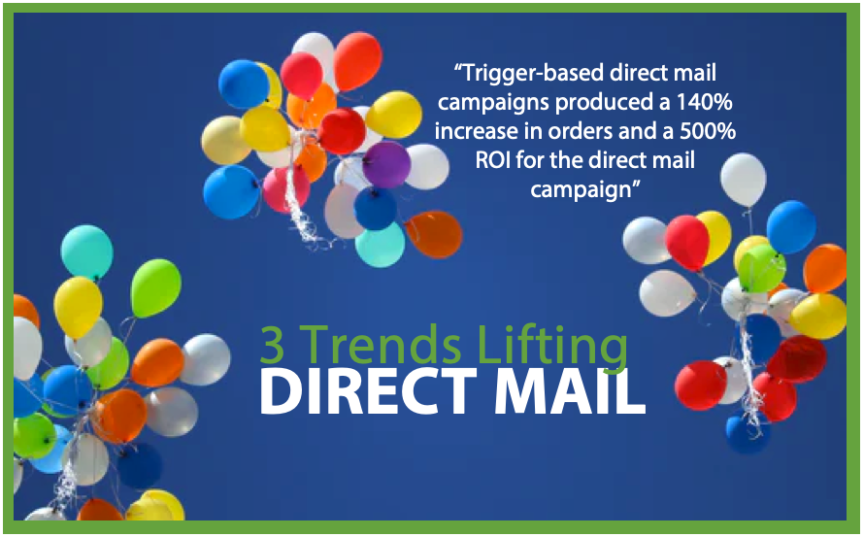Direct mail continues to be a critical component for many marketing plans for both B2C and B2B products and services. It’s always more effective than digital-only channels like email or social media ads. Three trends are driving new strategies in direct mail marketing.
- Consumer expectations for brands to know my preferences
- More data and tracking to understand the correlation between online and offline transactional behaviors
- Inkjet technology driving improved and complex workflow
Earlier in my career, I was responsible for executing direct mail acquisition programs for clients across vertical markets. Our strategies were defined by the print and mail production capabilities available in the 1990s. We defined offers and campaigns based on using pre-printed forms and economically sorting data into manageable lots for printing postal processing and mailing. We were able to support limited personalization including names and addresses on mail pieces. We then manually managed versions in physical batches to test various offers and packages. We manually tracked lots and version codes during production. Larger campaigns often took four to six weeks to execute.
Today direct mail production has evolved with highly complex, data-driven workflows. Inkjet production eliminates the physical constraints for batches and segmentation by supporting complete variable data and personalization while optimizing printing and postal processing. Marketers no longer must plan direct mail campaigns with large batches of data records and a few versions to get an acceptable cost per piece.
Programmatic Direct Mail
Some of the most effective direct mail campaigns are now programmatic and trigger-based campaigns with multi-channel communications. In a recent industry webinar Judith Maloy, Director and CEO of Polaris Direct shared the latest trends driving client success stories. Polaris is executing multi-channel solutions by leveraging data. Data allows them to create highly personalized direct mail offers based on consumer preferences and online behavior.
With workflows driven by highspeed inkjet technology, Polaris provides timely direct mail campaigns enhanced with digital retargeting ads across the Google network and social media platforms on Facebook and Instagram. Trigger-based direct mail allows for individualized offers and personalized content based on online behaviors. When consumers visit an ecommerce site and don’t buy, a highly targeted postcard is sent to the consumer within 48 hours. These programmatic, multi-channel campaigns are producing exponential growth and demonstrated ROI for Polaris’ clients. Read more about Polaris’ ecommerce home décor success story.
More Data Driving Workflow
Marketers of products and services now can leverage vast amounts of data about consumer preferences, lifestyles and purchase history to understand common traits between online and offline customer behaviors. Armed with this data marketers are building direct marketing strategies to increase conversion rates and generate sales. Sophisticated data providers like Data Axle have platforms that create predictive models and scoring of data to enable marketers to mail to consumers more likely to buy the offered products. Data can accurately predict the best offer, for the right product, at the right time, and through the right channel for each consumer.
Inkjet production workflows allow for personalization based on data analytics, versions and targeted offers so records to be combined into one print job providing economies of scale in the printing and mailing process. Transactional online data is combined with demographic and psychographic information to inform data models and consumer profiles. Production files are then created by appending data for physical mailing addresses to individual records. These trigger-based campaigns produce results marketers love increased consumer engagement, interest and purchases. Timely offers producing higher conversions and sales that can be attributed to specific direct mail offers and campaigns. And the more data used, the smarter the predictive modeling tools become over time.
Printers who embrace the data tools, strategic partners and automated workflows are able to demonstrate to marketers and brands an ROI for direct mail and multi-channel campaigns.
Batch of 1
A software platform from Postalytics further enhances direct mail strategies by fully automating direct mail with no minimum requirements for number of pieces in a campaign. Marketers are leveraging their direct mail automation platform to enable new use cases for direct mail. Marketers are no longer bound by lot and batch size to create relevant messages or direct mail offers.
The Postalytics platform uses feeds from CRM systems like Salesforce, HubSpot and others, to allow trigger-based direct mail to be automatically sent to individuals. The production workflows with inkjet technology combine records from several clients into logical lots based on formats for letters and postcards which enable fixed price costs associated with large direct mail batched campaigns.
Marketers have relied on email as their primary channel to communicate with customers for upselling and cross selling, and to win back lapsed customers. Email is cheap and it supports targeted messaging. The downside is email’s open and click-through rates are dropping as consumers are overwhelmed by the amount of email in their inboxes.
Inkjet is the backbone of personalization
Dennis Kelly, President of Postalytics, shared a B2B success story. One of their clients sells products to health clubs and gyms. The brand had a marketing strategy where they only invested in direct mail for their new customer acquisition programs. And they primarily used email for their retention and ongoing client communications.
They were experiencing declining open rates to their customer emails – negatively impacting their upsell and cross sell sales results. By leveraging data from their CRM system and automation from Postalytics, the brand added direct mail trigger campaigns to create more engagement with existing customers.
They sent triggered direct mail offers to those customers who stopped opening emails. By any marketing measure the results are impressive. Trigger-based direct mail campaigns produced a 140% increase in orders and a 500% ROI for the direct mail campaign. Astounding? Yes, and only possible with inkjet driving the fully variable data, images, and content management in the production process. You can read more about this notable case study on their site.
Software and production inkjet are enabling direct mail campaigns of 1 with no restraints, while allowing cost economies for print, mail, and postal processing. Most importantly, the technology drives marketers greatest desire to provide timely offers, in the mail in 48 hours, which are relevant to each recipient. With high-speed inkjet technology and an automated direct mail platform, each mail piece is fully personalized for all content and images. Also, automated workflows support upfront postal processing across data sets from multiple clients to maximize postal discounts.

Multi-channel follows the eyeballs
Companies like Polaris Direct, Data Axle and Postalytics are enabling their clients to define and execute new strategies for direct mail campaigns. ED Krug VP of Strategic Solutions from Data Axle touts how they can turn browsers into buyers by targeting consumers who are most likely to buy their clients’ products and services. Digital retargeting positions ads in front of consumers who have visited specific websites with appealing offers. The data is used to reinforce their specific direct mail offer based on online activity.
Many marketing programs are now measured by customer satisfaction driven by customer experience. Customer experience is increasingly as important as the features and benefits of a product or service, in determining if customers buy. Smart marketers have evolved their direct mail campaigns to leverage data to define complex strategies for highly personalized, relevant and timely offers for each consumer.
Automation, relevance, timely offers
As online engagement and shopping continues to grow, smart brands are deploying more complex but effective marketing strategies. Inkjet is the engine that delivers results for data driven direct mail. Marketers are learning and showing measurable results for their multi-channel direct mail campaigns. These results are driving increased adoption of programmatic and trigger-based direct mail.
For more proof points on multi-channel direct marketing and the marketing lift of inkjet, see our recent interview with SG360.

